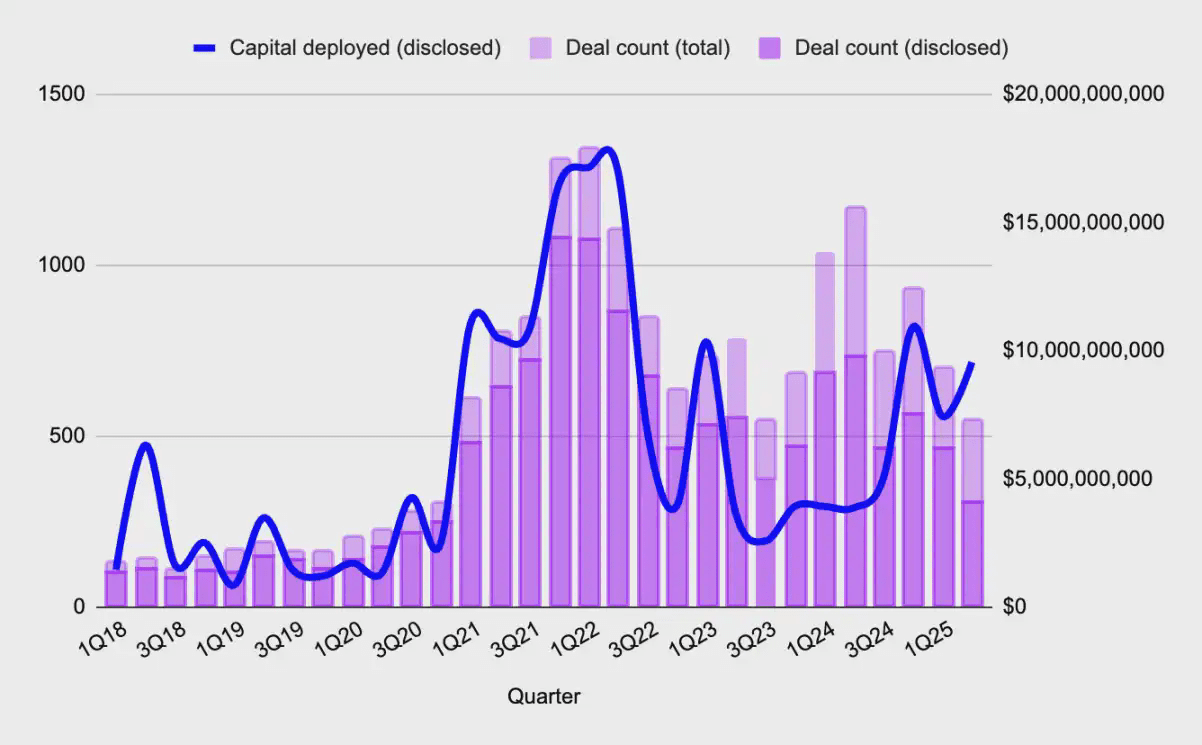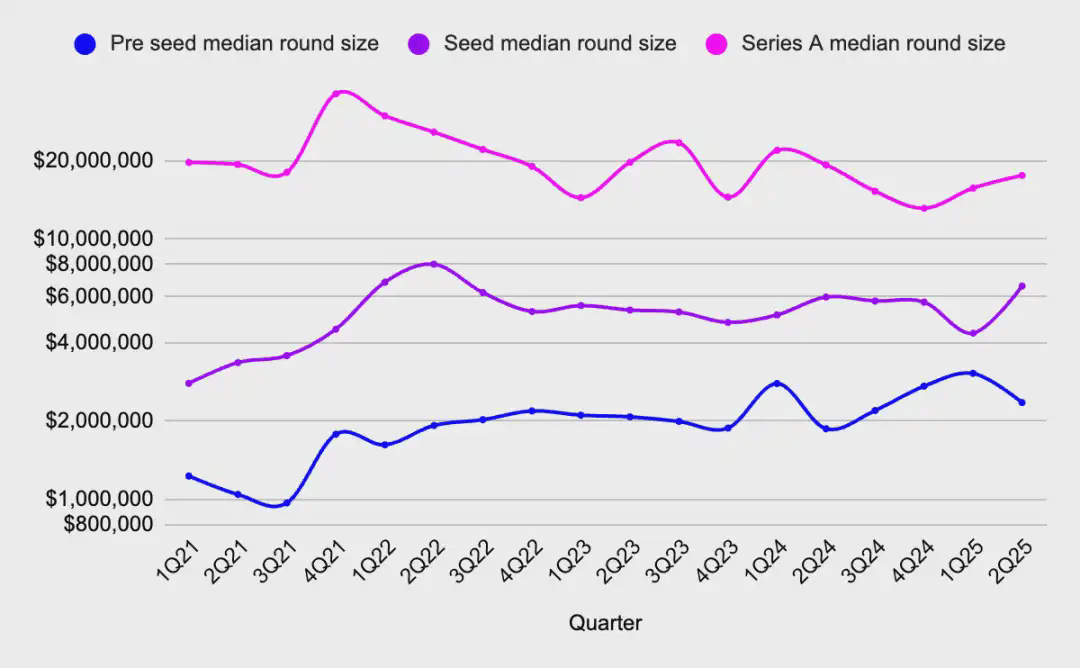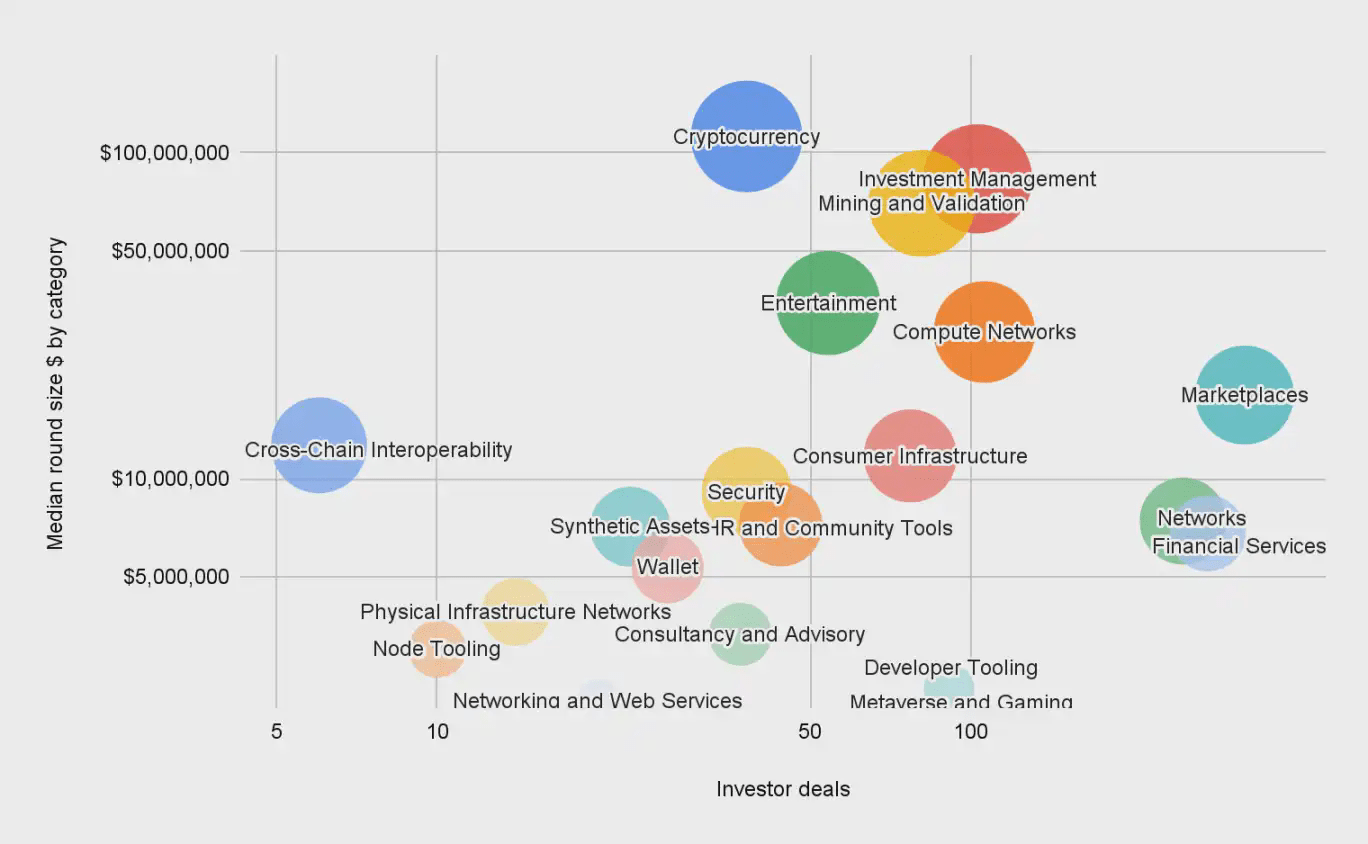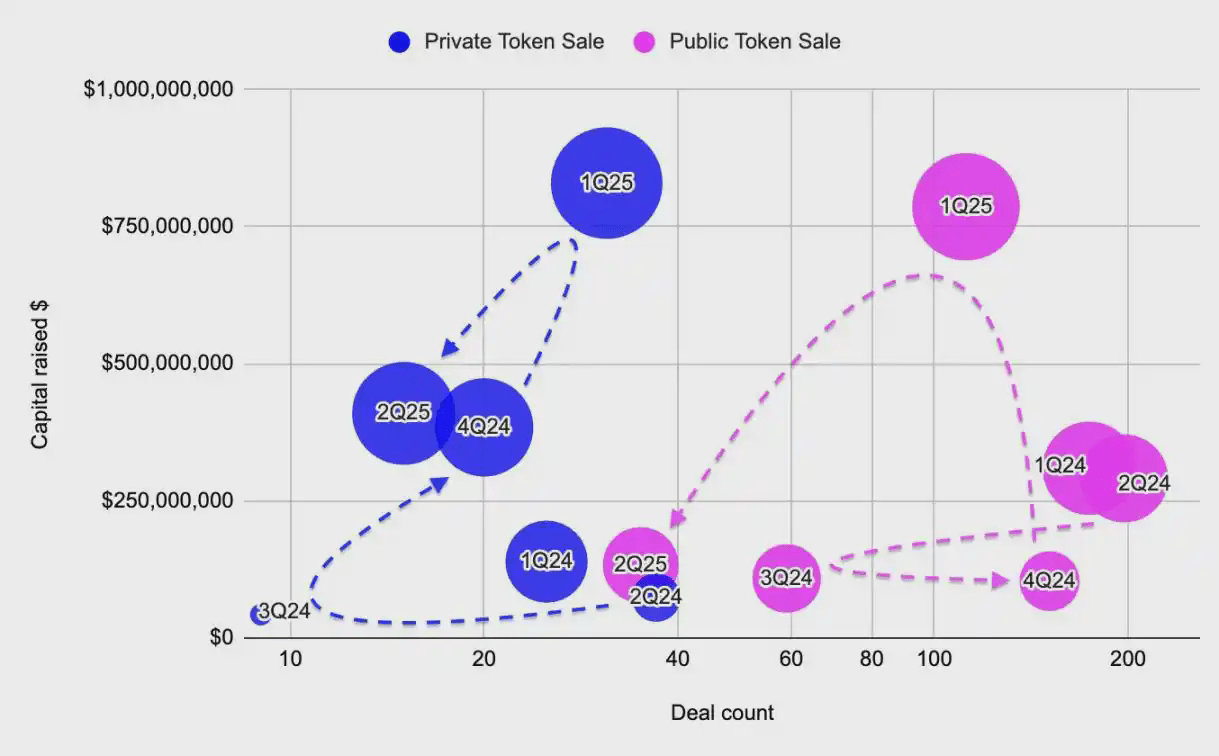Web3 venture capital surged to $9.6 billion, marking the second highest quarterly total on record, despite the number of disclosed transactions dropping to just 306.
Capital concentration is intensifying. Fewer companies are raising more funds, with median sizes of financing rounds across all stages increasing. Series A financing has reached $17.6 million, the highest level in over two years.
The amount for the seed round has risen. The median size of seed round financing has jumped to $6.6 million, reversing the decline seen in the first quarter, indicating increased confidence in early-stage capital.
Private token sales remain stable, raising $410 million through just 15 transactions. Public token sales fell by 83%, with only 35 activities raising $134 million.
Infrastructure continues to dominate, with cryptocurrency, mining and validation, and computing networks leading in terms of capital and investor interest.
Consumer categories show a glimmer of vitality, especially in financial services and markets, but the financing scale and transaction share are still relatively small.
This quarter's financing trend shows that this is no longer a game of casting a wide net, but rather a very thorough faith investment.
Market overview: capital concentration.
At first glance, the numbers seem contradictory: Web3 venture capital totals have surged, but the number of transactions has plummeted. However, in the broader adjustment context we have been tracking since 2024, the logic becomes clear: investors are shifting from broad coverage to deeper, more strategic bets, and Q2 2025 solidified this shift.

This quarter recorded only 306 disclosed transactions (transactions with financing details published): the lowest level since mid-2023. However, financing amounts soared to nearly $10 billion, nearly 30% higher than the previous quarter, but without any outlier transactions at an extremely large scale. We did not see a single oversized transaction distorting the data, but rather dense financing rounds ranging from $50 million to $250 million, concentrated in strategic areas such as rollup infrastructure and validator liquidity. The prominent characteristic of this quarter's financing is fewer bets, larger rounds, and higher thresholds.
The result is that the market feels smaller but also more serious. In an environment following oversized funds, investors are not chasing every financing pitch; they are comprehensively considering narratives, protocol dependencies, and distribution advantages. You are no longer funded for being promising, but for being indispensable.
Stages of financing for Web3 startups: Series A returns.
After being overlooked for a year, Series A financing has returned to the spotlight.
The median for Series A financing has climbed to $17.6 million, the highest level since early 2022, with 27 transactions raising a total of $420 million. These are no longer 'quasi-Series B' financings disguised as Series A; they are precise and prudent capital allocations for those companies with strong product-market fit (PMF), which usually have growing revenues and well-structured token mechanisms.

The seed round has rebounded, with the median size of seed round financing rising to $6.6 million, while the total number of transactions has slightly increased. This indicates that investors are returning to early-stage risk interests, at least in popular areas such as AI-native infrastructure or validator tools. Meanwhile, the pre-seed round remains stable, with a median of $2.35 million, confirming what we have seen over the past year: early projects are still present.
In 2024, capital is concentrated at both ends: one is the optimism of the pre-seed stage, and the other is the maturity of Series B and beyond. Series A was once a place of belief extinction, but the risk market will not remain stagnant forever. Infrastructure takes time to build, scaling also takes time, and that moment has now arrived.
Infrastructure investment dominates Web3 capital flows.
This quarter's capital-weighted Web3 category map serves as a blueprint for post-consumer transformation.
 The largest financing sizes occurred in infrastructure (median $112 million), mining and validation (median $83 million), and computing networks (median $70 million). These are not speculative tokens but infrastructure that supports validator networks, modular block space, and AI-aligned consensus systems; this foundational layer defines long-term blockchain investment strategies. The logic for investors is clear: support the underlying infrastructure and then rapidly grow the application layer.
The largest financing sizes occurred in infrastructure (median $112 million), mining and validation (median $83 million), and computing networks (median $70 million). These are not speculative tokens but infrastructure that supports validator networks, modular block space, and AI-aligned consensus systems; this foundational layer defines long-term blockchain investment strategies. The logic for investors is clear: support the underlying infrastructure and then rapidly grow the application layer.
Other prominent infrastructure areas include consumer infrastructure (median $11.7 million) and asset management (median $83 million). These categories sit at the intersection of infrastructure and user experience (UX), representing high-functionality products with technological depth and long-term composability.
On the other hand, developer tools once again attracted strong capital interest (91 investor transactions), but the financing amounts were relatively small. This is a familiar narrative for this long-tail, low capital expenditure industry. However, it remains a playground for early teams and those willing to participate in grants and token options games.
Financial services, entertainment, and markets achieved healthy transaction numbers and moderate median financing sizes (ranging from $6 million to $18 million), indicating stable and cautious investor attention. However, their transaction volumes are far from the levels seen in 2021-2022. Investors have not lost interest in consumer applications; they are just waiting for new products to emerge.
Q2 2025 Token Financing: Private and Public.
After a booming first quarter, token financing entered a calmer phase in the second quarter, but this shift seems more like a redistribution rather than a retreat.
 Private token sales raised $410 million through just 15 transactions, with a median financing size of $29.3 million, the highest level since 2021. The growth of this high-value private allocation highlights the current financing environment in Web3: consistency and strategic partnerships are more important than hype. These are not meme coins driven by speculation or utility tokens disguised as agreements, but rather validator alliances, L2 treasuries, and modular rollup ecosystems quietly solidifying liquidity.
Private token sales raised $410 million through just 15 transactions, with a median financing size of $29.3 million, the highest level since 2021. The growth of this high-value private allocation highlights the current financing environment in Web3: consistency and strategic partnerships are more important than hype. These are not meme coins driven by speculation or utility tokens disguised as agreements, but rather validator alliances, L2 treasuries, and modular rollup ecosystems quietly solidifying liquidity.
In contrast, public token sales have collapsed. Only 35 financings were completed, down from 112 in the first quarter, totaling just $134 million, with the median financing size halved. Even offerings popular with retail investors struggle to attract attention, with most trading volume concentrated in a few high-profile projects. Beyond that, market sentiment feels more like a wait-and-see stance rather than bearish, indicating a posture of waiting and observing rather than a full retreat.
The divide between private and public sales continues the trend tracked since the end of 2023. Public token offerings surged when the market was hot, but private rounds reflect consistency rather than hype.
Summary
Investors are looking for clearer narratives, more solid infrastructure, and builders who know how to navigate this new financing environment.
If 2024 is a year of recovery and restructuring, then Q2 2025 feels like a year of silent execution.
Capital is flowing, but only to a few. Transaction flows are decreasing, but financing sizes are increasing. Infrastructure continues to win, not out of bias, but without any significant ideological shifts.
The road for founders has narrowed, but it is not unmanageable; early transactions are still occurring, and Series A financing has returned. As long as they align with strategic, scalable, and protocol-dependent goals, private tokens have regained a genuine seat at the negotiating table.
In short: we have exited the hype cycle of the entire market. This is a slow, pressurized climb, targeting those important infrastructures and enduring applications.
The conclusion is simple: this market does not need more hype cycles; it needs inevitability.